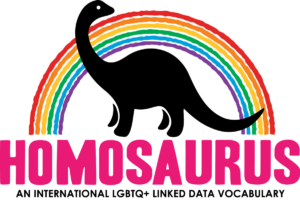Historically, the classification and cataloging of LGBTQ+ materials in libraries has been less than inclusive. While the overriding desire of Emory catalogers is to make your resources relevant and representative – as well as easy to find – we have been restricted by a traditional approach that can sometimes feel limited, or even biased.
Fortunately, current work is pointing a spotlight at these practices and efforts to highlight and improve the situation are ongoing. One such project, which seeks to offer a more inclusive way to catalog and classify resources, is the Homosaurus.
Cataloging 101
When a resource is added to the library databases, catalogers choose subject terms from controlled lists to ensure that the material in question is correctly described and – ultimately – findable. Traditionally, the most utilized controlled list comes from the Library of Congress (LC). This can sometimes cause problems. The LC established their subject terms in 1897 based on their existing collection and – unsurprisingly – these subject terms were centered around a Western, white, male, cisheteronormative perspective.
Furthermore, when it comes to terms relating to the LGBTQ+ community, the headings used for classification by the LC were often derived from psychological and medical literature. This literature tended to link marginalized sexual or gender identities to sexual perversions and disorders.
While the LC does have some LGBTQ+ subject headings, they can feel overly broad. “Gay men,” for example, works in many scenarios, but is limited. There are terms within the LGBTQ+ community which are more appropriate. These might include “Queer men,” “Baby gay,” “Macho men,” “Queens (Gay culture),” or “Bears (Gay culture).” None of these more specific terms can be accurately described by current LC subject headings.
Enter the Homosaurus
The Homosaurus is an international linked data vocabulary of Lesbian, Gay, Bisexual, Transgender, and Queer (LGBTQ+) terms.
It began life in 1993 when Jack Van der Wal from the Netherlands developed a thesaurus focused on gay and lesbian life and culture. Since then, it has been restructured and expanded – resulting in the finalization of version three in September 2022. The Homosaurus is officially available in English and Dutch and a grant to create an authorized Spanish version is in the works.
The Homosaurus difference
While work to make the subject terms incorporated by the LC less biased has been ongoing since the 1960s, the creaky wheels of library bureaucracy move slowly.
In direct contrast, the vocabulary provided by the Homosaurus has been carefully curated to reflect thoughtful subject analysis of LGBTQ+ materials, to offer better representation of LGBTQ+ related topics in the Emory Libraries’ catalog, and – most importantly – to ensure that the vocabulary used in cataloging is the current language of the LGBTQ+ community.
Notably, while the LC must justify the change or addition of a subject term by proving it exists in published resources, the Homosaurus can make additions or revisions based on the use of a term within the LGBTQ+ community. It takes into consideration how many people are using the term as well as the context which surrounds it. It is this difference which enables the Homosaurus to be an agent of change for equality and inclusion.
The Homosaurus at Emory
The Homosaurus will offer the Emory community many benefits.
- It will allow library users to search for resources using inclusive vocabularies which are preferred by the communities they are researching.
- It will increase the visibility of resources by adding additional headings referring to the same phenomenon. Think STD versus sexually transmitted diseases. This will allow users who may not be sure of the appropriate term to conduct successful searches.
- It will allow users to search our collections for focused resources which describe specific groups, subcultures, and identities within the LGBTQ+ community.
- It will allow researchers across all academic disciplines to hunt for resources within the catalog more effectively and efficiently. Consider projects examining transgender health, indigenous expressions of sexuality, or feminist and queer philosophy – to name but a few. All these will benefit from the vocabulary and discoverability offered by the Homosaurus.
As a first step of implementing the Homosaurus in the Emory catalog, we have asked one of our library vendors (Backstage) to look at ALL our existing bibliographic records and their LC subject headings and to add equivalent Homosaurus terms where appropriate.
Some examples of subject and genre terms resulting from Backstage’s initial work are LGBTQ+ biographies, Queer biographies, LGBTQ+ films, African American LGBTQ+ people, African American gay men, and LGBTQ+ clergy.
Future plans
Moving forward, we will continue to think about how to improve the subject analysis and terminology offered in the Homosaurus. Backstage will convert the LC subject terms to Homosaurus vocabulary on an ongoing basis and we will also continue to update records with Homosaurus terms during ongoing cataloging. We are providing training to Emory cataloging staff to ensure proper use of this new vocabulary. We hope to collaborate with subject matter experts and librarians to identify areas of the existing collection that will benefit from exploration and the further addition of Homosaurus terms.
Check it out
We hope that you love the Homosaurus as much as we do, and we encourage you to check it out. As always – we welcome and encourage feedback and questions. Please direct these and other comments or enquiries to: Sofia Slutskaya at sofia [dot] slutskaya [at] emory [dot] edu
-Tara Kunesh, Resource Description Specialist Senior, Woodruff Library

